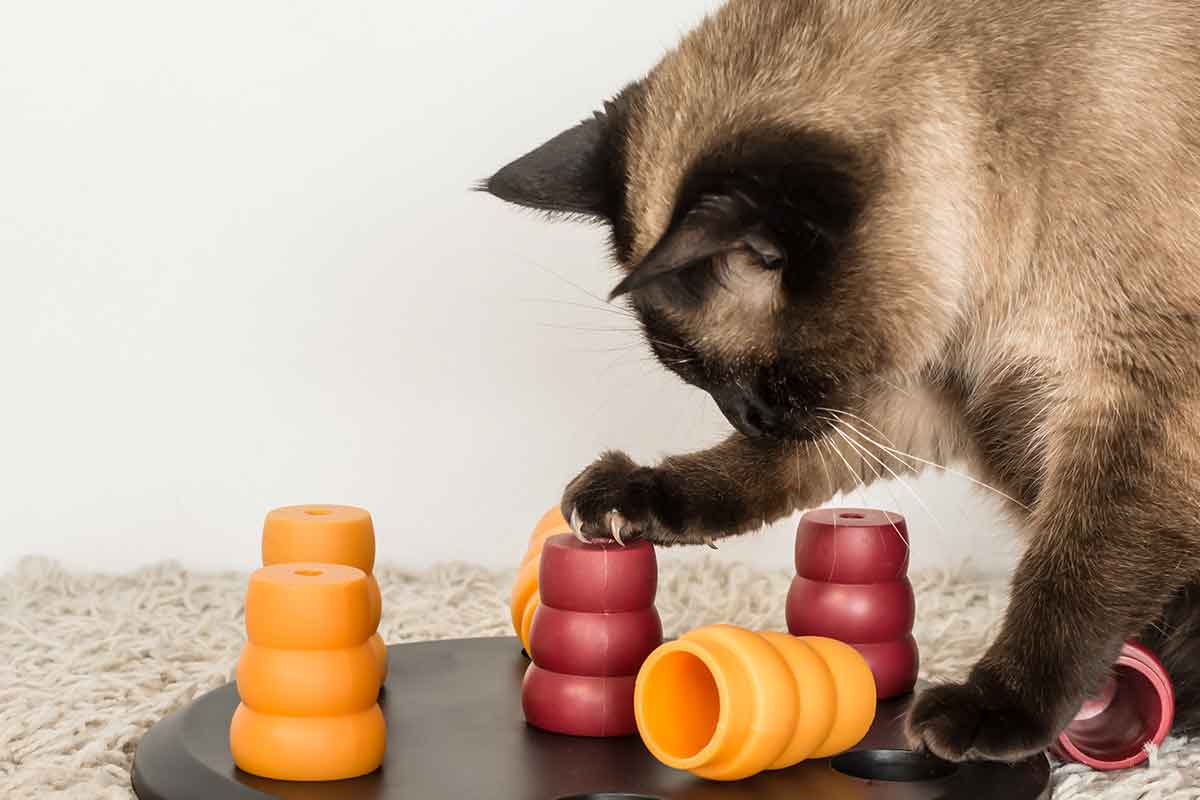What we feed our cats is a topic worthy of discussion. But just as important, we need to talk about how we feed our cats.
Most cat caretakers feed their cats from bowls. And most of those leave dry food out 24/7.
The theory is that cats don’t naturally scarf down meals all at once — and that is true. Outdoors, they catch what they can when they can. But given an all-you-can-eat buffet in homes, most cats eat unnaturally large meals all at once, and then return for even more. Exacerbating the issue is that most cats have little else to do but eat.
That’s not normal. Worse, it can affect cats’ behavior.
Easy Meals Trigger Stress
Not being able to search out and capture a meal appears to be potentially stressful for indoor cats. Living in a dull and stagnant environment induces anxiety in cats, according to research by feline expert Tony Buffington, DVM, when he was at the Ohio State University College of Veterinary Medicine (he’s now a clinical professor volunteer at the UC Davis School of Veterinary Medicine and honorary research fellow at University of Bristol, School of Veterinary Sciences).
Other researchers have studied how community cats and barn cats naturally spend time. According to “Behaviour and ecology of free-ranging farm cats,” International Journal Behavioural Ethology, Panaman,P. 1981, outdoor cats rest or sleep a lot at 62 percent of the day. Cats like to catnap. This information doesn’t stop the presses. But resting typically occurs after they spend time seeking, hunting, and feeding, which accounts for 19 percent of their time. (The remaining time is spent grooming or playing). Various other studies confirm similar data.
Let’s face it: cats are born with a prey drive. They are hard-wired to seek, hunt, and pounce. Having toys to chase or pounce on is important. Still, it’s not the same as hunting for a meal. In our homes, there’s no opportunity for cats to hunt and eat in a natural way, and this needs to change.
Food Factors
For cats, finding food in a bowl is predictable and doesn’t account for any measurable time or effort. In multi-cat homes, we have little idea who has eaten what. And that leads to another problem. A big one.
Statistically speaking, the majority of cat owners have, on average, just over two cats, according to the American Veterinary Medical Association. With two or more cats in a household, it’s difficult to gauge whether one cat is eating more than another. You may not figure it out until the cat’s next checkup when the veterinarian says, “Your lovely Ladybird here has gained three pounds since her last visit.”
I suggest that by offering food on the proverbial silver platter, we’re not allowing cats to be cats. In fact, there’s mounting evidence to demonstrate that many animals would rather work for food than have it offered freely, a phenomenon called contrafreeloading. Studies have been limited to some zoo animals and lab rodents, but if grizzly bears, meerkats, and lab rats prefer to labor to get their meals, why not cats and dogs?
Buffington discovered that providing structure and an enriched environment can solve or prevent the problem of chronic stress as a by-product of living in a dull environment. If zoos can enrich the lives of lions and tigers, cat caretakers can certainly provide appropriate enrichment for domestic cats.
Find Your Cat’s Inner Hunter
Cats are hunters. Allow them to hunt. And cats can hunt indoors.
Some veterinary behaviorists and cat behavior consultants have been talking about the concept of creating ways for cats to activate their prey drive indoors. Dr. Elizabeth Bales put all the science together and created a feeding system for cats called the Indoor Cat Feeder.
The feeding system features objects resembling mice, into which kibble is deposited. The dispensers consist of a soft outer “skin” to simulate prey and a BPA-free plastic inner container, which holds one-fifth of the cat’s daily ration. There are two holes on the back of each food dispenser.
The idea is to split a meal among the five dispensers and to hide them for cats to find, using their innate hunting skills, including a keen sense of smell. Begin by “hiding” them in easy places for the cats to find and increase the level of difficulty as needed. Cats learn to hunt indoors by finding each food-filled dispenser, pouncing on it, and manipulating the devices to dispense small meals.
In multi-cat homes, generally there’s enough food for all if you purchase one system per cat. Another option is to continue feeding as you are now, but to leave some (perhaps approximately 25 percent) of the cats’ meals in the dispensers, so your cats get some “hunting” time. (When ordering the Indoor Cat Feeder, use the discount code CATSWINN to support the nonprofit Winn Feline Foundation)
The Indoor Cat Feeder isn’t the only choice; there are lots of food puzzles available at most pet stores and online.
AIKIOU is a champion of interactive feeders, including one called the Thin Kat. Northmate makes a product called the Slow Feed Bowl. A favorite is the Catit Design Food Maze. The idea is to activate cats’ natural instincts and prey drives and give them some physical exercise as predator seeking “prey,” as well as mental stimulation.
If you feed canned food, take the plastic lids you use to seal the cat food can, turn them upside down, and use the same technique to disperse the food to different locations around the house.
For families with dogs, keep the food-dispensing objects inside cat beds or boxes on cat trees, window ledges, or furniture above dog level.
There are ways to encourage indoor cats to be cats, even indoors.
This article was reviewed/edited by board-certified veterinary behaviorist Dr. Kenneth Martin and/or veterinary technician specialist in behavior Debbie Martin, LVT.








